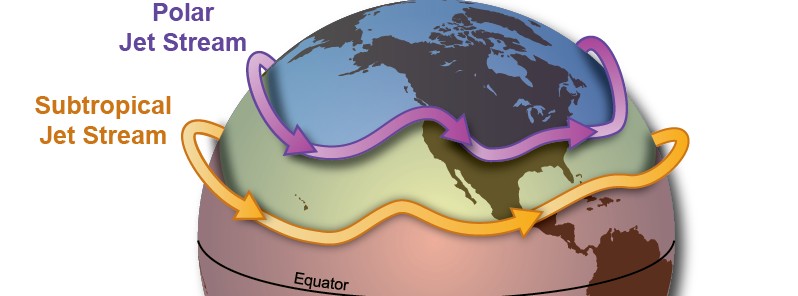Research shows jet stream is moving northwards, winter jet stream increased by 8%

New research led by the National Oceanography Centre (NOC) and ICARUS presented seasonal to decadal variations in Northern Hemisphere jet stream latitude and speed over land (Eurasia, North America) and oceanic (North Atlantic, North Pacific) regions for the period 1871 – 2011 from the Twentieth Century Reanalysis dataset.
Jet streams are fast, narrow air bands, which flow around the globe in both hemispheres at around 10 km (6.2 miles) above the surface. The flow is predominantly zonal from west to east with jet speeds reaching 45 to 70 ms−1 and possibly higher in winter. Their variations have a significant impact on storm activity and temperature patterns across the northern hemisphere, and accordingly, impact the environment and society.
The study found significant regional differences on seasonal to decadal timescales. Seasonally, the jet latitude range is lower over the oceans compared to land, reduced from 20° over Eurasia to 10° over the North Atlantic where the ocean meridional heat transport is greatest.
The mean jet latitude range is at a minimum in winter (DJF), particularly along the western boundary of the North Pacific and North Atlantic, where the land-sea contrast and sea surface temperature gradients are strongest.
The 141-year trends in jet latitude and speed show differences on a regional basis.
The North Atlantic has significantly increasing jet latitude trends in all seasons, up to 3° in winter.
Eurasia has significant increasing trends in winter and summer, however, no increase is seen across the North Pacific or North America.
Jet speed shows significant increases evident in winter (up to 4.7 ms−1), spring and autumn over the North Atlantic, Eurasia and North America however, over the North Pacific no increase is observed.
Long-term trends are generally overlaid by multidecadal variability, particularly evident in the North Pacific, where 20-year variability in jet latitude and jet speed are seen, associated with the Pacific Decadal Oscillation which explains 50% of the winter variance in jet latitude since 1940.
The results highlight that northern hemisphere jet variability and trends differ on a regional basis (North Atlantic, North Pacific, Eurasia and North America) on seasonal to decadal timescales, suggesting that different mechanisms are influencing the jet latitude and speed.
This is important from a climate modeling perspective and for climate predictions in the near and longer term.
The research was supported by the Marine Institute and funded by the Irish Government under the JPI Climate and JPI Ocean joint call and the Natural Environmental Research Council and involved collaboration between The Irish Climate Analysis Research Units (ICARUS) at Maynooth University in Ireland, University of Southampton, UK and National Oceanography Centre, UK.
References:
"A regional (land–ocean) comparison of the seasonal to decadal variability of the Northern Hemisphere jet stream 1871–2011" – Hallam, S., Josey, S.A., McCarthy, G.D. et al. – Clim Dyn (2022). – https://doi.org/10.1007/s00382-022-06185-5
Featured image credit: NWS

So, how did they measure the Jet Stream velocity six miles above the earth’s surface in the year 1881 to come up with this 141 year trend?
is it full of creamy nougat though? certificate of complete college asks better ones!
mankind is responsible for the pollution, but only the sun controls the weather. At this time it readies itself and all the planets for its 12,000 year cycle of nova. This in turn is readying us for a polar reversal. To what degree I do not know. It will be a hard time life on the planet. There will be a great cleansing…In our history it has happened many times, caused great extinctions and altered the face of the planet. …but we survived..
Well, that’s what happens when one GEO-ENGINEERS the WEATHER!
Multidecadal increase in latitude of Northern Hemisphere jet stream coincides with increase in latitude of North Magnetic Pole towards Indian Ocean